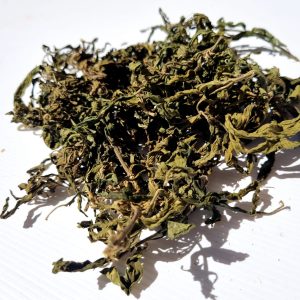| Leonotis leonurus, also known as lion’s tail and wild dagga, is a plant species in the mint family, Lamiaceae. The plant is a broadleaf evergreen large shrub native to South Africa and southern Africa, where it is very common. It is known for its medicinal properties. The main psychoactive component of Leonotis leonurus is claimed to be leonurine, even though leonurine has never been found in the plant using chemical analysis. Like other plants in the mint family, it also contains marrubiin. The name ‘wild dagga’ links it closely to cannabis as ‘dagga’ derived from the Khoikhoi ‘dachab’ is an indigenous South African name for cannabis species. This name may be a misnomer, as no part of the plant is used as a hallucinogen.
|
The shrub grows 3 to 6 ft (1 to 2 m) tall by 1.5 to 3.5 feet (0.46 to 1.07 m) wide. The medium-dark green 2–4 inches (5.1–10.2 cm) long leaves are aromatic when crushed. The plant has tubular orange flowers in tiered whorls, typical to the mint family, that encircle the square stems. They rise above the foliage mass during the summer season, with flowering continuing into winter in warmer climates.
Variation in flower colorA white variety (known colloquially as ‘Alba’) and a yellow variety also exist. EcologyThe native habitat of Leonotis leonurus is damp grasslands of southern Africa. It attracts nectivorous birds (mainly sunbirds), as well as various insects such as butterflies. The flowers’ mainly orange to orange-red colour and tubular shape are indicative of its co-evolution with African sunbirds, which have curved bills suited to feeding from tubular flowers. CultivationLeonotis leonurus is cultivated as an ornamental plant for its copious orange blossom spikes and is used as an accent or screen in gardens and parks. It is moderately drought tolerant, and a nectar source for birds and butterflies in landscape settings. It was introduced to Europe in the 1600s. Lion’s tail can especially be found in other subtropical and Mediterranean climate regions beyond South Africa such as California, Hawaii, and Australia where it has naturalized in areas. In cooler climates it is used as an annual and winter conservatory plant. Pharmacology and toxicologyThe main active component marrubiin has both antioxidant and cardioprotective properties and has shown to significantly improve myocardial function. One experimental animal study suggests that the aqueous leaf extract of Leonotis leonurus possesses antinociceptive, antiinflammatory, and hypoglycemic properties. An animal study in rats indicated that in high doses, lion’s tail has significant toxicological adverse effects on organs, red blood cells, white blood cells and other important bodily functions. Acute toxicity tests in animals caused death for those receiving 3200 mg/kg dose. At 1600 mg/kg extract led to changes in red blood cells, hemoglobin concentration, mean corpuscular volume, platelets, and white blood cells. Traditional usesThe infusions made from flowers and seeds, leaves or stems are widely used to treat tuberculosis, jaundice, muscle cramps, high blood pressure, diabetes, viral hepatitis, dysentery, and diarrhoea. The leaves, roots and bark are used as an emetic for snakebites, bee and scorpion stings. The fresh stem juice is used as an infusion drunk for ‘blood impurity’ in some places of South Africa. Recreational usesThe dried leaves and flowers have a mild calming effect when smoked. In some users, the effects have been noted to be similar to the cannabinoid THC found in Cannabis, except that it has a much less potent high. It has also been reported to cause mild euphoria, visual changes, dizziness, nausea, sweating, sedation and lightheadedness. It is sometimes used as a Cannabis substitute by recreational users as an alternative to illegal psychoactive plants. |
|


Reviews
There are no reviews yet.